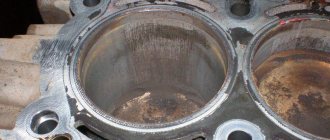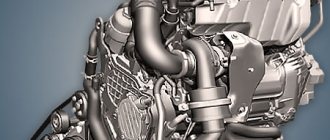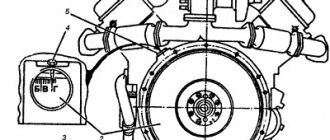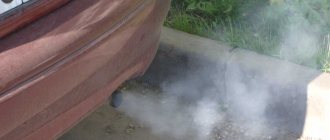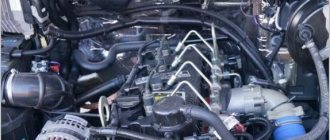Changing filters
Let's not criticize the quality of fuel at gas stations. It is important for us that there is almost no way to check this parameter in advance. Well, of course, if the paraffin does not fall out of the filling nozzle in pieces. But if there is water or sand in the fuel, all hope lies in the filters, which are highly recommended to be replaced in the fall. At a minimum, drain the water (or make sure there is no water) if the design of the fuel system allows for this possibility. In general, we read the manuals, look for filters (pay attention to their number), change them. The air can be waved for company. For perfectionists - salon too.
And candles...
Where do spark plugs come from in a diesel car? They are there. These are glow plugs that heat the combustion chambers before starting the engine. Actually, if they work, then there is no need to change them, but if not, it is critically important to replace them. Why do they get so much attention, since it’s generally logical to replace broken parts? Because in the summer, faulty spark plugs may not be noticeable, but during the first cold weather it will cause the engine to not start. So we check if everything is okay with them.
What are the difficulties of starting a car engine in cold weather?
In diesel engines, fuel is ignited due to the heat generated by the air during sudden and strong compression in the cylinders. If initially the engine itself and the air entering it are very cool, then with the same amount of thermal energy generated during compression due to cranking of the starter, the temperature of the mixture after injection of cold diesel fuel may be below the ignition threshold.
On the subject: How and with what to defrost a car lock
But this is not the only factor; a number of others can be listed:
- insufficient compression in the cylinders, the engine is badly worn, and the oil, which is supposed to lubricate and seal the gaps in the rings, has lost its properties during cooling;
- the starter cannot rotate the crankshaft with the required intensity, since the battery does not discharge a charge well in the cold;
- the rotation of the crankshaft by the starter may be prevented by too viscous oil in the crankcase;
- diesel fuel turned out to be summer fuel, that is, when the temperature dropped below zero, gel-like paraffin chains began to form in it, clogging the fuel lines, the filter, and disrupting the operation of the high-pressure fuel pump (HPF);
- The glow plugs that heat the air in the combustion chambers do not work well or have completely failed.
As a result, without taking additional measures, the diesel engine cannot be started after a long period of parking. A long period of parking here can be considered, during which the car has managed to cool down to ambient temperature, which usually takes a few hours, and it is guaranteed to cool down overnight.
Let's warm ourselves up
A felt blanket or a car blanket, any kind, even the standard plastic protection of the engine compartment from below and the notorious cardboard in front of the radiator, is a must-have. On other cars, without all this, the engine may reach operating temperature about twenty minutes after the start of the trip. Well, the stove won’t start heating up soon either.
Battery
Diesel cars use more powerful batteries. It is more difficult to turn such an engine, if only because of the high compression, which is about twice as high here as on a gasoline engine. Plus frozen oil, loss of electricity in the cold... In short, winter should be met with an ideal battery with a capacity no lower than that prescribed by the car manufacturer. By the way, how many of them do you have there? Two? We clean the terminals, measure the density of the electrolyte, and visit a familiar electrician. The last two points are rather in reverse order.
Operation and warming up of diesel engines in winter
Every year there are more and more cars with diesel engines on domestic roads. However, if we compare their number with European countries, it remains relatively small. Why is that? The answer is simple: many drivers who would like to replace their gasoline car with a diesel one do not dare to do so, fearing that operating diesel engines in winter will bring them many problems. Indeed, cold weather can cause a lot of headaches. Although if you adhere to some simple rules for operating diesel cars, then everything will happen without any special incidents.
Content:
Oil
Nothing special here. If the time has come, then change the engine oil to a thinner one, one of those specified in the instructions. In short, meeting the winter with oil where the first number in the 5W40 type marking is higher than five is not a good idea. Five, in particular, means that the minimum temperature at which it is possible to pump lubricating fluid through the system is 35 degrees below zero, and in this case you should not turn the engine with the starter after minus thirty. If you get started, of course!
Warming up the engine in winter and summer
In summer, warming up the engine is strongly recommended. The movement should be started only a minute after the engine has started, since it is during this period of time that all elements are lubricated with oil. To reduce excessive load on the engine, it is better not to make sudden movements and move smoothly before the temperature approaches fifty degrees.
Operating a diesel engine in the winter requires complete warming up, since the oil in the engine and gearbox begins to thicken at low temperatures. The oil should become liquid and only then can you gain high speed. The duration of warming up depends on the air temperature; the lower it is, the longer you will need to wait.
The movement should begin when the temperature reaches 60 degrees. In this case, it is recommended not to gain speed more than two thousand, and the speed should not exceed twenty km/h until the temperature reaches normal. In addition, it is better not to turn on the cabin heater until the engine warms up to sixty degrees, otherwise the air flow coming from it will be cold.
All of the above tips will help the driver save time and avoid further problems with the diesel unit, as well as significantly extend its service life.
Fuel
We have it in sixth place, but it can easily jump to first if you fill something wrong. We know summer and winter, but no one knows what will flow from the refueling nozzle under the guise of one or the other. All hope lies in the good name of the gas station. The closer the gas station is to civilization, the higher the hope. In the outback there may be no choice. And in big cities too. Just remember Almaty in the fall of 2017, when low-quality fuel purchased at various gas stations was consumed even at a slight minus. We look at the weather forecast and choose how much summer to pour into the tank. In winter, you can safely fill it full.
According to Technical Regulation 013/2011 of the Customs Union “On the requirements for automobile and aviation gasoline, diesel and marine fuel, jet fuel and fuel oil,” information about the name and brand of fuel, including the environmental class, must be posted at gas stations in places accessible to consumers, and information about the brand of fuel is reflected on fuel dispensing equipment and in cash register receipts. At the consumer's request, the seller is obliged to present a copy of the fuel quality document (passport).
The rules for labeling diesel fuel are specified in Appendix 1 to TR CU 013/2011. The marking consists of a group of characters arranged in a certain sequence separated by a hyphen:
- letters DT (diesel fuel);
- the letters L (summer), Z (winter), A (arctic), E (interseasonal), indicating the climatic conditions of use;
- symbols K2, K3, K4, K5, indicating the environmental class of diesel fuel.
The brand designation may include the manufacturer's trademark.
Why is diesel difficult to start in cold weather?
First of all, it is necessary to understand the main aspects that complicate starting a diesel engine in cold weather. There are several possible reasons, and each of them can be decisive. All owners of such cars need to provide high-quality service so that cold starts do not become a constant problem, do not have to warm up the car or use wires for lighting. The main factors complicating the launch are:
- In cold weather, diesel fuel begins to solidify, since it contains a lot of paraffins, which harden at subzero temperatures. To solve the problem, a winter version of fuel for diesel engines is sold, which contains additives that allow it to maintain normal consistency at temperatures down to minus 40°C.
- Motor oil and other lubricating fluids also become thicker in cold weather, which creates additional difficulties: all moving parts are much more difficult to turn. Before winter, you should fill in fresh oil with a reduced viscosity so that it does not harden so much during temperature changes and does not complicate starting the diesel engine.
- In cold weather, the battery capacity decreases, which can become a problem: to start a diesel car, you need much more energy than a gasoline version. Therefore, the battery must be in full working order so that it does not run out after 2-3 starting attempts. An excellent solution is a gel battery; it practically does not change its characteristics in cold weather, so it is ideal for diesel-powered cars.
- Worn or malfunctioning glow plugs will not allow a cold diesel engine to start properly. Ideally, you need to check them once a year in order to detect faults in a timely manner and replace failed components in warm weather. If you take this point into account, then you won’t have to urgently look for service and repair the car.
Important! For the winter, it is best to fill in synthetic motor oil; under operating conditions at subzero temperatures, it thickens much less.
In diesel cars, timely maintenance is very important, since they are much more demanding than gasoline cars. Even minor malfunctions, which are not of particular importance in the summer, can become a big problem in the winter. It is especially important to maintain good technical condition in regions with low temperatures.
They sent something wrong
You can increase the freezing point of summer diesel fuel by adding antigel to it. There are many such compounds; they are sold at most gas stations, but it is better for a diesel engine driver to have one with him. And here (attention!) you can’t just splash anti-gel into frozen diesel fuel. More precisely, it is possible, but it will not work. Any instructions say that the additive must be mixed with liquid diesel fuel. In other words, in advance. A life hack from experienced diesel drivers will come in handy: in the enze you need to have not a jar of anti-gel, but a bottle with one and a half liters of kerosene in which the anti-gel has already been diluted. The chances of bringing the contents of the tank to life by pouring such a cocktail into it are much higher. Diesel fuel can also be diluted with simple kerosene in a ratio of 1/10, but, say, in situations where there are signs of freezing of the fuel or a very severe frost is approaching.
It is interesting that, according to Appendix 3 to TR CU 013/2011, which lists the requirements for the characteristics of diesel fuel, the filterability temperature limit (this parameter actually determines the temperature limit of its use) for summer diesel fuel is not determined at all. For off-season in all countries of the Customs Union this parameter is -15, and for winter -20 degrees Celsius. But... not in Kazakhstan. For Kazakhstan these are -5 and -15, respectively.
Additional equipment
You can install many different heaters on a diesel, as well as a gasoline, car. For diesel engines, heating the fuel intake, fuel line, fuel filter, flow-through fuel heaters, as well as various universal “boilers” for antifreeze operating from a household electrical network and autonomous heaters are relevant. Experienced installers of such systems usually have recommended solutions depending on the vehicle model. And the apotheosis of preparation for winter can be the installation of a gasoline autonomous heater on a diesel engine, the kit of which will include an additional tank for gasoline, a filler neck, pipelines or the need to make a tank from stainless steel, as well as, in especially severe cases, inserting a second fuel hatch into the fender of the car . This is a difficult and expensive path, which, however, is followed by other SUV owners. But then they can consider themselves ready for anything.
But additional electrical equipment has one drawback, which refers us to point two - the risk of getting a warmed-up car, but with a completely drained battery. And then another battery and a separate charging system for it are added to the list of necessary items. True, this is a completely prohibitive level of preparation. Although in such a car you can go off-grid even for the whole winter, and cut the summer diesel fuel into bricks and put it in a trailer.
About a kettle for dummies
Sudden frost, summer diesel in the tank - the engine does not start. What to do? Pour a cocktail with anti-gel into the tank, rock the car from side to side (we're not talking about trucks, right?). And go get a kettle. Drinking tea until it warms up is a good idea, but you can splash boiling water on the fuel equipment (or get a bottle of hot water from the tap). Often after this procedure the car starts. It is worth mentioning that not all cars have fuel equipment in the usual sense. For example, pouring boiling water over an injector pump will not work.
Pros and cons of warming up a diesel engine in winter
On the topic of warming up a diesel engine in winter, many manufacturers say that modern turbo engines have a fuel injection system that allows you to start moving immediately. This is justified by the fact that the oil film is not washed off from the liners by fuel due to the correctly implemented supply of diesel fuel.
However, the fact remains that the oil thickens, and the diesel fuel also becomes viscous, and until it reaches the necessary parameters, it is still not worth starting to move.
We recommend, in our winter conditions, if possible, to warm up the engine to at least 40-50 degrees before the trip.
Advantages of warming up the engine at low temperatures:
- Optimal distribution of engine oil inside the engine, resulting in reduced wear. The engine is not subject to accelerated wear.
- The car has a smoother ride.
- Fuel economy. For the same time interval (10 minutes), the difference can differ by 3-4 times.
- Driving in a warm interior is much more pleasant.
Read also in the article - how to start a diesel car in cold weather.
Disadvantages of warming up the engine:
- Environmental pollution.
- Spark plugs are subject to high stress.
- Waiting for the engine to warm up.
Scary?
We unwittingly collected almost all the horror stories for diesel drivers. But if you look at it, the main recommendations boil down to keeping the car in good working order, performing all routine maintenance on time and refueling with high-quality fuel. With the latter, of course, sometimes difficulties arise. And even taking this into account, many car owners, when preparing their cars for winter, rarely move beyond the fifth point. Still scared? Then pay attention to the item “additional equipment”. By the way, we plan to develop the topic of additional equipment on the pages of our publication.
General recommendations for speeding up warm-up
To begin with, we list general recommendations that any car owner living in the corresponding latitudes needs to know about. First of all, you need to remember that you need to warm up the engine only at idle speed, so as not to apply a significant load to it. Be sure to keep an eye on your car's battery charge. And do not turn on any electrical appliances when the car is not running. First let the engine start and warm up normally. For some modern foreign cars, warming them up while driving is allowed, but subject to two mandatory conditions. Firstly, at low engine speeds (about 1000 rpm). And secondly, if the frost outside is slight (not lower than -20° and provided that motor oil with the appropriate viscosity is used). However, it is still better to warm up even foreign cars at idle speed, since this way you can preserve the life of the engine, in particular, the crank mechanism.
To start and accelerate warm-up, we recommend using the following algorithm:
- the air intake to the stove must be turned on from the street;
- set the climate control performance to the minimum value (if available, otherwise do the same with the stove);
- turn on the window blowing mode;
- turn on the heater or climate control fan;
- if there are heated seats, you can turn it on;
- when the coolant temperature is around +70°C, you can turn on the warm mode on the stove, while simultaneously turning off the air intake from the street.
With the listed algorithm of actions, the driver will have to endure the first few minutes at sub-zero temperatures, however, the described procedure is guaranteed to speed up the warming up of both the engine and the passenger compartment itself.
As for the time during which it is worth warming up the engine, as a rule, 5 minutes is enough for this. However, there are several nuances here. If you have an older car whose engine does not warm up as quickly, then this time may not be enough. But according to the current Traffic Rules, a vehicle cannot be in a crowded place with the engine idling for more than 5 minutes. Otherwise, a fine will be imposed. But if the car is in a garage or in a parking lot, then this requirement can be neglected. And while the engine is warming up, you can clear the ice from the glass and side mirrors.
To quickly warm up, it will be more effective to use additional devices and devices designed to speed up the heating of the car's power unit.

